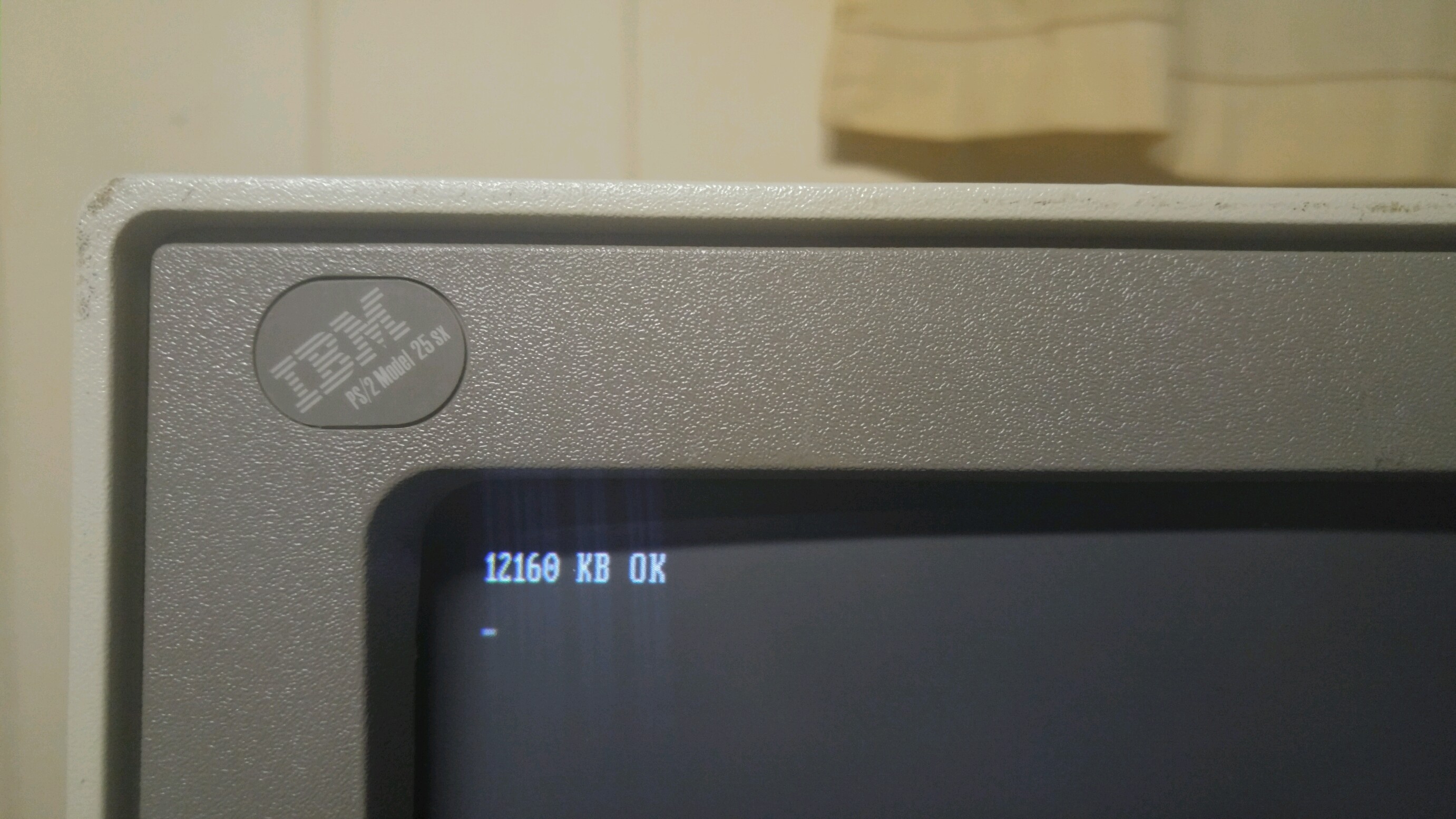|
IBM Multicolor Graphics Adapter
The Multi-Color Graphics Array or MCGA is a video subsystem built into the motherboard of the IBM PS/2 Model 30, introduced on April 2, 1987, and Model 25, introduced later on August 11; no standalone MCGA cards were ever made. The MCGA supports all CGA display modes plus 640×480 monochrome at a refresh rate of 60 Hz, and 320×200 with 256 colors (out of a 18-bit RGB palette of 262,144) at 70 Hz. The display adapter uses a DE-15 connector. MCGA is similar to VGA in that it had a 256-color mode (the 256-color mode in VGA was sometimes referred to as MCGA) and uses 15-pin analog connectors. The PS/2 chipset's limited abilities prevents EGA compatibility and high-resolution multi-color VGA display modes. The tenure of MCGA was brief; the PS/2 Model 25 and Model 30 were discontinued by 1992, and no manufacturer produced a clone of this display adapter except for Epson Equity Ie and Epson PSE-30, since the VGA standard introduced at the same ... [...More Info...] [...Related Items...] OR: [Wikipedia] [Google] [Baidu] |
IBM PS/2 Model 30
The Personal System/2 Model 30 and Personal System/2 Model 30 286 are IBM's entry-level desktop computers in their Personal System/2 (PS/2) family of personal computers. As opposed to higher-end entries in the PS/2 line which use Micro Channel bus architecture, the Model 30 features an Industry Standard Architecture bus, allowing it to use expansion cards from its direct predecessors, the PC/XT and the PC/AT. The original PS/2 Model 30 is built upon the Intel 8086 microprocessor clocked at 8 MHz; the Model 30 286 features the Intel 80286 clocked at 10 MHz. Development and release The PS/2 Model 30 was introduced in April 1987 alongside the Model 50 and Model 60—entries in the PS/2 line which feature the new Micro Channel architecture bus, as opposed to the Model 30's Industry Standard Architecture bus previously used in IBM's PC/XT. The Model 30 is the most entry-level in the PS/2 lineup, with the dual-floppy-drive unit costing 1,695 and the floppy–hard drive combo unit costi ... [...More Info...] [...Related Items...] OR: [Wikipedia] [Google] [Baidu] |
Enhanced Graphics Adapter
The Enhanced Graphics Adapter (EGA) is an IBM PC graphics adapter and de facto computer display standard from 1984 that superseded the CGA standard introduced with the original IBM PC, and was itself superseded by the VGA standard in 1987. In addition to the original EGA card manufactured by IBM, many compatible third-party cards were manufactured, and EGA graphics modes continued to be supported by VGA and later standards. History EGA was introduced in October 1984 by IBM,High-Resolution Standard Is Latest Step in DOS Graphics Evolution, ''InfoWorld'', June 26, 1989, p. 48News Briefs, Big Blue Turns Colors, ''InfoWorld'', October 8, 1984 shortly after its new PC/AT. The EGA could be installed in previously released IBM PCs, but required a ROM upgrade on the mainboard. Chips and Technologies first product, announced in September 1985, was a four chip EGA chipset that handled the functions of 19 of IBM's proprietary chips on the original Enhanced Graphics Adapter. By that ... [...More Info...] [...Related Items...] OR: [Wikipedia] [Google] [Baidu] |
Computer Display Standards
Computer display standards are a combination of aspect ratio, display size, display resolution, color depth, and refresh rate. They are associated with specific expansion cards, video connectors and monitors. History Various computer display standards or display modes have been used in the history of the personal computer. They are often a combination of aspect ratio (specified as width-to-height ratio), display resolution (specified as the width and height in pixels), color depth (measured in bits per pixel), and refresh rate (expressed in hertz). Associated with the screen resolution and refresh rate is a display adapter. Earlier display adapters were simple frame-buffers, but later display standards also specified a more extensive set of display functions and software controlled interface. Beyond display modes, the VESA industry organization has defined several standards related to power management and device identification, while ergonomics standards are set by the ... [...More Info...] [...Related Items...] OR: [Wikipedia] [Google] [Baidu] |
List Of Defunct Graphics Chips And Card Companies
{{Unreferenced, date=June 2010 During the 1980s and 1990s a relatively large number of companies appeared selling primarily 2D graphics cards and later 3D. Most of those companies have subsequently disappeared, as the increasing complexity of GPUs substantially increased research and development costs. Many of these companies subsequently went bankrupt or were bought out. Intel and VIA Technologies remain as producers of primarily integrated solutions, while Matrox targets niche markets. Amongst the notable discrete graphics card vendors, ATI Technologies — acquired by AMD in 2006 and since renamed to AMD — and NVIDIA are the only ones that have lasted. Defunct graphics chip makers These companies designed graphics chips and cards. *3dfx Interactive - assets were acquired by NVIDIA during its Chapter 11 bankruptcy *3Dlabs - merged with Creative Labs' personal entertainment division to form ZiiLABS *Advanced Logic Research – acquired by Gateway Computers *Ark Logic * ... [...More Info...] [...Related Items...] OR: [Wikipedia] [Google] [Baidu] |
Microprose
MicroProse is an American video game publisher and developer founded by Bill Stealey, Sid Meier, and Andy Hollis in 1982. It developed and published numerous games, including starting the ''Civilization'' and '' X-COM'' series. Most of their internally developed titles were vehicle simulation and strategy games. In 1993, the company lost most of its UK-based personnel and became a subsidiary of Spectrum HoloByte. Subsequent cuts and corporate policies led to Sid Meier, Jeff Briggs and Brian Reynolds leaving and forming Firaxis Games in 1996, as MicroProse closed its ex-Simtex development studio in Austin, Texas. In 1998, following an unsuccessful buyout attempt by GT Interactive, the struggling MicroProse (Spectrum HoloByte) became a wholly owned subsidiary of Hasbro Interactive and its development studios in Alameda, California and Chapel Hill, North Carolina were closed the following year. In 2001, MicroProse ceased to exist as an entity and Hasbro Interactive sold the MicroPr ... [...More Info...] [...Related Items...] OR: [Wikipedia] [Google] [Baidu] |
Lucasfilm Games
Lucasfilm Games (known as LucasArts between 1990 and 2021) is an American video game licensor that is part of Lucasfilm. It was founded in May 1982 by George Lucas as a video game development group alongside his film company; as part of a larger 1990 reorganization of the Lucasfilm divisions, the video game development division was grouped and rebranded as part of LucasArts. LucasArts became known for its line of adventure games based on its SCUMM engine in the 1990s, including '' Maniac Mansion'', the '' Monkey Island'' series, and several '' Indiana Jones'' titles. A number of influential game developers were alumni of LucasArts from this period, including Brian Moriarty, Tim Schafer, Ron Gilbert, and Dave Grossman. Later, as Lucasfilm regained control over its licensing over the ''Star Wars'' franchise, LucasArts produced numerous action-based ''Star Wars'' titles in the late 1990s and early 2000s, while dropping adventure game development due to waning interest in the g ... [...More Info...] [...Related Items...] OR: [Wikipedia] [Google] [Baidu] |
Sierra On-line
Sierra Entertainment, Inc. (formerly On-Line Systems and Sierra On-Line, Inc.) was an American video game developer and publisher founded in 1979 by Ken and Roberta Williams. The company is known for pioneering the graphic adventure game genre, including the first such game, '' Mystery House''. It is also known for its graphical adventure game series ''King's Quest'', '' Space Quest'', '' Police Quest'', ''Gabriel Knight'', ''Leisure Suit Larry'', and ''Quest for Glory'', as well as being the original publishers of Valve's ''Half-Life'' series. After seventeen years as an independent company, Sierra was acquired by CUC International in February 1996 to become part of CUC Software. However, CUC International was caught in an accounting scandal in 1998, and many of the original founders of Sierra including the Williamses left the company. Sierra remained as part of CUC Software as it was sold and renamed several times over the next few years; Sierra was formally disestablished as ... [...More Info...] [...Related Items...] OR: [Wikipedia] [Google] [Baidu] |
D-subminiature
The D-subminiature or D-sub is a common type of electrical connector. They are named for their characteristic D-shaped metal shield. When they were introduced, D-subs were among the smallest connectors used on computer systems. Description, nomenclature, and variants A D-sub contains two or more parallel rows of pins or sockets usually surrounded by a D-shaped metal shield that provides mechanical support, ensures correct orientation, and may screen against electromagnetic interference. D-sub connectors have gender: parts with pin contacts are called ''male connectors'' or ''plugs'', while those with socket contacts are called ''female connectors'' or ''sockets''. The socket's shield fits tightly inside the plug's shield. Panel mounted connectors usually have #4-40 UNC (as designated with the Unified Thread Standard) jackscrews that accept screws on the cable end connector cover that are used for locking the connectors together and offering mechanical strain relief, and can ... [...More Info...] [...Related Items...] OR: [Wikipedia] [Google] [Baidu] |
IBM PS/2 Model 25
The Personal System/2 Model 25 and its later submodels the 25 286 and 25 SX are IBM's lowest-end entries in the Personal System/2 (PS/2) family of personal computers. Like its sibling the Model 30, the Model 25 features an Industry Standard Architecture bus, allowing it to use expansion cards from its direct predecessors, the PC/XT and the PC/AT—but not from higher entries in the PS/2 line, which use Micro Channel. Unlike all other entries in the PS/2 line, the Model 25 and its submodels are built into an all-in-one form factor, with its cathode-ray tube (CRT) monitor and system board occupying the same enclosure. IBM oriented the Model 25 at home office workers and students. Development and release IBM unveiled the Model 25 on August 4, 1987. It is the fifth entry of the Personal System/2 range. The first Model 25 is powered by an Intel 8086 running at 8 MHz, roughly twice the speed of the original IBM Personal Computer. A college student-oriented version of the Model ... [...More Info...] [...Related Items...] OR: [Wikipedia] [Google] [Baidu] |
List Of Monochrome And RGB Color Formats
This list of monochrome and RGB palettes includes generic repertoires of colors ( color palettes) to produce black-and-white and RGB color pictures by a computer's display hardware. RGB is the most common method to produce colors for displays; so these complete RGB color repertoires have every possible combination of R-G-B triplets within any given maximum number of levels per component. Each palette is represented by a series of color patches. When the number of colors is low, a 1-pixel-size version of the palette appears below it, for easily comparing relative palette sizes. Huge palettes are given directly in one-color-per-pixel color patches. For each unique palette, an image color test chart and sample image ( truecolor original follows) rendered with that palette (without dithering Dither is an intentionally applied form of noise used to randomize quantization error, preventing large-scale patterns such as color banding in images. Dither is routinely used in proce ... [...More Info...] [...Related Items...] OR: [Wikipedia] [Google] [Baidu] |
Motherboard
A motherboard (also called mainboard, main circuit board, mb, mboard, backplane board, base board, system board, logic board (only in Apple computers) or mobo) is the main printed circuit board (PCB) in general-purpose computers and other expandable systems. It holds and allows communication between many of the crucial electronic components of a system, such as the central processing unit (CPU) and memory, and provides connectors for other peripherals. Unlike a backplane, a motherboard usually contains significant sub-systems, such as the central processor, the chipset's input/output and memory controllers, interface connectors, and other components integrated for general use. ''Motherboard'' means specifically a PCB with expansion capabilities. As the name suggests, this board is often referred to as the "mother" of all components attached to it, which often include peripherals, interface cards, and daughterboards: sound cards, video cards, network cards, host bus adapt ... [...More Info...] [...Related Items...] OR: [Wikipedia] [Google] [Baidu] |



_logo.png)


